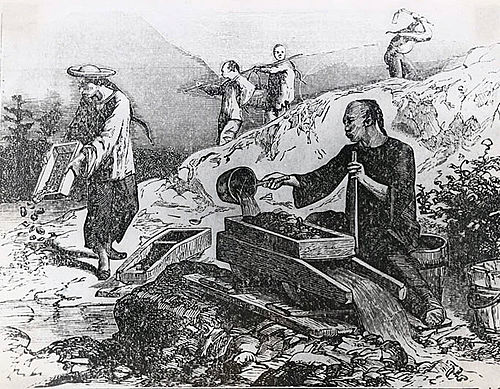
Illustration: From Roy D. Graves pictorial collection, preserved and maintained for the public by the Division of Cultural Resources and Museum Management, which includes the Park Archives and Records Center (PARC).
Introduction
The 19th century witnessed a significant influx of Chinese immigrants into the United States, a movement shadowed by the grim realities of human trafficking for both sex and labor. This era, marked by rapid industrialization and evolving immigration patterns, saw Chinese men and women being subjected to exploitative conditions under the guise of promising opportunities. This essay aims to shed light on the causes, nature, and consequences of this trafficking, emphasizing its impact on the Chinese community and American society at large.
Causes of Immigration and Trafficking
The primary catalyst for the mass migration of Chinese people to the United States was the California Gold Rush of 1848. The allure of wealth and the demand for labor in gold mines and later in the construction of the Transcontinental Railroad attracted thousands of Chinese laborers. Concurrently, there was a sinister undercurrent of trafficking, primarily driven by economic desperation in China and the demand for cheap labor and sexual services in the U.S.
Trafficking for Labor: The Railroad and Beyond
A significant number of Chinese immigrants were trafficked to work on the Transcontinental Railroad under false promises and coercive contracts. These laborers, known as “coolies,” faced brutal working conditions, low wages, and severe discrimination. Beyond the railroads, this exploitation extended to other industries such as mining, agriculture, and fishing, where Chinese laborers were often treated as disposable workforce.
Trafficking for Sex: Exploitation in the Shadows
Parallel to labor trafficking, there was a disturbing trend of trafficking Chinese women for sexual exploitation. Many of these women were deceived or coerced into leaving China and were sold into prostitution in the burgeoning Chinatowns of American cities. These women lived in appalling conditions, trapped in a cycle of abuse and control by traffickers and brothel owners. The societal stigma and legal constraints of the time left them with little recourse for escape or justice.
Legal and Social Response
The trafficking of Chinese people in the U.S. prompted a range of legal and social responses. The most notable was the Chinese Exclusion Act of 1882, the first significant law restricting immigration to the U.S. on the basis of race. While ostensibly aimed at curbing labor competition, it also reflected xenophobic sentiments and failed to address the root causes or the plight of trafficked individuals. Efforts by missionaries and early human rights advocates provided some support to the victims, but were often limited in their reach and impact.
Lasting Impacts and Reflections
The trafficking of Chinese people in the 19th century for sex and labor has left a lasting impact on the Chinese-American community and the broader fabric of American society. It highlighted issues of racial discrimination, labor exploitation, and the complexities of immigration. The experiences of these immigrants and their resilience in the face of adversity have contributed significantly to the diverse narrative of American history.
Conclusion
The trafficking of Chinese people to the United States in the 19th century is a poignant chapter in the history of immigration and labor. It serves as a stark reminder of the human cost of economic exploitation and the enduring challenges of racial and social justice. Understanding this period is crucial in recognizing the historical patterns of exploitation and in forging a path towards more humane and equitable treatment of immigrants and minority communities.

